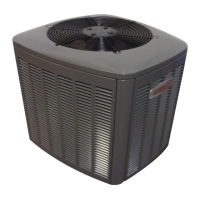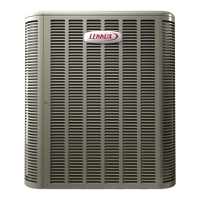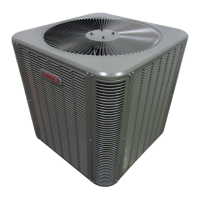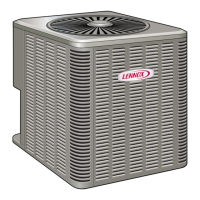Page 12
505366M 01/08
WARNING
Refrigerant can be harmful if it is inhaled.
Refrigerant must be used and recovered
responsibly.
Failure to follow this warning may result in personal
injury or death.
WARNING
Fire, Explosion and Personal Safety
Hazard.
Failure to follow this warning could
result in damage, personal injury or
death.
Never use oxygen to pressurize or
purge refrigeration lines. Oxygen,
when exposed to a spark or open
flame, can cause damage by fire and/
or an explosion, that could result in
personal injury or death.
After the line set has been connected to both the indoor
and outdoor units, check the line set connections at both
the indoor and outdoor units unit for leaks. Use the
following procedure to test for leaks:
1. Connect an HCFC−22 manifold gauge set high
pressure hose to the suction valve service port.
NOTE − Normally, the high pressure hose is connected to
the liquid line port; however, connecting it to the suction
port better protects the manifold gauge set from high
pressure damage.
2. With both manifold valves closed, connect the cylinder
of HCFC−22 refrigerant to the center port of the
manifold gauge set. Open the valve on the HCFC−22
cylinder (suction only).
3. Open the high pressure side of the manifold to allow
HCFC−22 into the line set and indoor unit.
4. Weigh in a trace amount of HCFC−22. [A trace amount
is a maximum of two ounces (57 g) refrigerant or three
pounds (31 kPa) pressure].
5. Close the valve on the HCFC−22 cylinder and the valve
on the high pressure side of the manifold gauge set.
6. Disconnect the HCFC−22 cylinder.
7. Connect a cylinder of dry nitrogen with a pressure
regulating valve to the center port of the manifold
gauge set.
NOTE − Amounts of refrigerant will vary with line lengths.
8. Adjust dry nitrogen pressure to 150 psig (1034 kPa).
9. Open the valve on the high side of the manifold gauge
set in order to pressurize the line set and the indoor unit.
10. After a few minutes, open one of the service valve
ports and verify that the refrigerant added to the
system earlier is measurable with a leak detector.
11. Check all joints for leaks.
12. Purge dry nitrogen and HFC−410A mixture.
13. Correct any leaks and recheck.
14. After leak testing disconnect gauges from service
ports.
Evacuating the System
WARNING
Danger of Equipment Damage. Avoid deep
vacuum operation. Do not use compressors to
evacuate a system. Extremely low vacuums can
cause internal arcing and compressor failure.
Damage caused by deep vacuum operation will
void warranty.
IMPORTANT
Use a thermocouple or thermistor electronic vacuum
gauge that is calibrated in microns. Use an instrument
capable of accurately measuring down to 50 microns.
Evacuating the system of non−condensables is critical for
proper operation of the unit. Non−condensables are
defined as any gas that will not condense under
temperatures and pressures present during operation of
an air conditioning system. Non−condensables and water
suction combine with refrigerant to produce substances
that corrode copper piping and compressor parts.
1. Connect manifold gauge set to the service valve ports
as follows:
low pressure gauge to suction line service valve
high pressure gauge to liquid line service valve
2. Connect micron gauge.
3. Connect the vacuum pump (with vacuum gauge) to
the center port of the manifold gauge set.
4. Open both manifold valves and start the vacuum
pump.
5. Evacuate the line set and indoor unit to an absolute
pressure of 23,000 microns (29.01 inches of
mercury).
NOTE − During the early stages of evacuation, it is
desirable to close the manifold gauge valve at least once to
determine if there is a rapid rise in sure indicates a
relatively large leak. If this occurs, repeat the leak testing
procedure.
NOTE − The term absolute pressure means the total
actual pressure within a given volume or system, above
the absolute zero of pressure. Absolute pressure in a
vacuum is equal to atmospheric pressure minus vacuum
pressure.
6. When the absolute pressure reaches 23,000 microns
(29.01 inches of mercury), close the manifold gauge
valves, turn off the vacuum pump and disconnect the
manifold gauge center port hose from vacuum pump.
Attach the manifold center port hose to a dry nitrogen
cylinder with pressure regulator set to 150 psig (1034
kPa) and purge the hose. Open the manifold gauge
valves to break the vacuum in the line set and indoor
unit. Close the manifold gauge valves.

